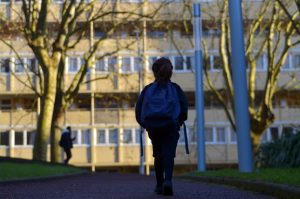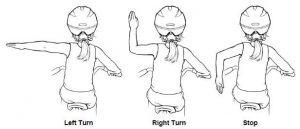No Time for Driver Negligence

The end of Daylight Savings Time (DST) in New England comes on the heels of Halloween, after the topic of child pedestrian safety is still fresh in the minds of many parents. The time change also shrouds neighborhoods in the afternoon and evening hours with dark skies, when children are walking home from school alongside tired Connecticut drivers meandering through neighborhoods on their way home from work, many who are driving just as fast as when it’s light out.
It’s important that children know how to safely travel on foot when the nights are longer; however, pedestrian-related accidents occurring around DST are ultimately tied back to driver negligence. Read on for more about how you can help make our streets safer for kids when it’s dark out.
How Drivers Can Help Keep Kids Safe
Drivers play a significant role in preventing pedestrian accidents when the days are shorter. Even though most of us savor the extra hour of sleep, unfortunately, there are those who take advantage of the longer night with increased alcohol consumption and further impair themselves on top of the disruption of the switch from DST to Standard time already has on sleeping patterns. This can take days or even a week to adjust to and many drivers fail to consider this when getting behind the wheel, lowering their awareness and increasing the odds of an accident.
How can you help keep our kids safe after the time change? You can be a better driver by:
- Staying up a few minutes later for a few days before the time change to help your body adjust. The better adjusted your body is, the more alert you will be.
- Don't rush while you're behind the wheel and follow the speed limit. Always be alert, especially when you are driving through residential neighborhoods.
- Yielding to pedestrians at all times and looking twice before proceeding. Your attentiveness helps alert other drivers to small children and your car acts as a barrier to them, signaling to rear traffic with your taillights.
- Understanding when to stop for buses: slow down for flashing yellow lights, and stop and look for children entering or exiting with red flashing lights and a stop sign. Wait for the lights to stop flashing, the stop sign to retract and the bus starts moving again before you continue driving.
For parents who are unable to pick their children up from school at this hour, how can you help best prepare your kids for the time change?
Getting Home Safely: Street Safety Tips for Kids
If your child walks home from school or sports practice each day, it might feel alarming as a parent to think about him or her walking the neighborhood when shorter days set in. At The Flood Law Firm, we believe in taking preventative measures to avoid hazardous and unsafe conditions, which is why we’ve put together a quick reference list for parents whose kids walk home during twilight hours.
Clear communication with your child will help alleviate some of the nerves. Take some time to go over the following tips together:
- Plan your child’s route. If you can, travel the route in your car once before to ensure it is well-lit with street lights as well as to familiarize yourself with it. Talk with your child about avoiding shortcuts or straying from the decided upon path.
- Walk on the sidewalk facing traffic as far left as possible. Teach your kids to be aware, and one way they can do this is by walking facing oncoming traffic as far left as possible. This helps them see any possible oncoming danger and allows them time to react if necessary. Where no sidewalk is available, instruct them to walk on the most left area out of the road or street.
- Make eye contact. This is a big one – ensure your child knows to make eye contact with a driver whenever possible before crossing in front of a vehicle. This can drastically cut down on accidents and teach your child to err on the side of caution.
- Cross at corners. Whenever possible, instruct your kids to use crosswalks or traffic signals and teach them to avoid crossing except at corners. Try to cross in a group whenever possible.
- Avoid phone use. If your child has a cellphone or electronic device, have them stash it away while they are walking home. Remind them to look for tail lights in driveways and teach them to always be aware of their surroundings.
- Get a flashlight. A Maglite flashlight is ideal, but any small flashlight is perfect for tucking away into their coat or small pocket of their backpack.
- Use reflective tape. You can find this at any hardware or home improvement store. Affix at least an inch or more of reflective tape to your child’s backpack, the back of a shoe or the hood of their coat for increased visibility by headlights. Some backpacks are even made with reflective material.
- Wear bright clothing. If your child doesn’t own a bright coat, a bright backpack or even shoes will also help increase their visibility in the shadows.
- Emphasize the buddy system. Arrange with a neighbor or another parent whose child lives close by or is involved in the same sport and have your kids travel in twos or threes.
Every parent wants to protect their child, and reviewing these simple precautions with him or her can help instill a sense of independence and responsibility by teaching them how to best protect themselves.
Daylight Savings Time can warrant extra precautions for other modes of transportation as well. If your child takes the bus or rides a bike home from school, here’s a few more tips for ensuring their safety in the darker afternoon hours:
Kids School Bus Safety
- Arrive at the bus stop 10 minutes early to avoid rushing or running.
- Stay in clear view of the bus driver and do not walk or stand behind the bus.
- Warn children not to walk 10 feet in front of the bus, which is the driver’s blind spot. Explain to your children that if they cannot see the bus driver’s face, the bus driver cannot see them.
Kids Bike and Scooter Safety
- Always wear a safety helmet. Remind your kids about their favorite athletes who wear helmets, such as Tony Hawk, Russell Wilson and Danica Patrick.
- See and be seen – always remain alert and aware.
- Listen for cars and avoid using headphones or playing music.
- Ride in the same direction as traffic flow, as far right as possible.
- Put reflective gear on the bike or scooter, or a blinker is great.
- Make sure the bike or scooter is in proper working condition.
- Use hand signals whenever possible and look before you turn.

If You Or Your Child Have Been Injured
Even when we’ve taken every precaution we can, accidents can still happen. If you or your child have been hurt in a bicycle, pedestrian, motor vehicle or bus accident, call the car accident attorneys at The Flood Law Firm at (860) 346-2695 for a risk-free, no obligation consultation. Your family’s safety and well-being matter to us.
